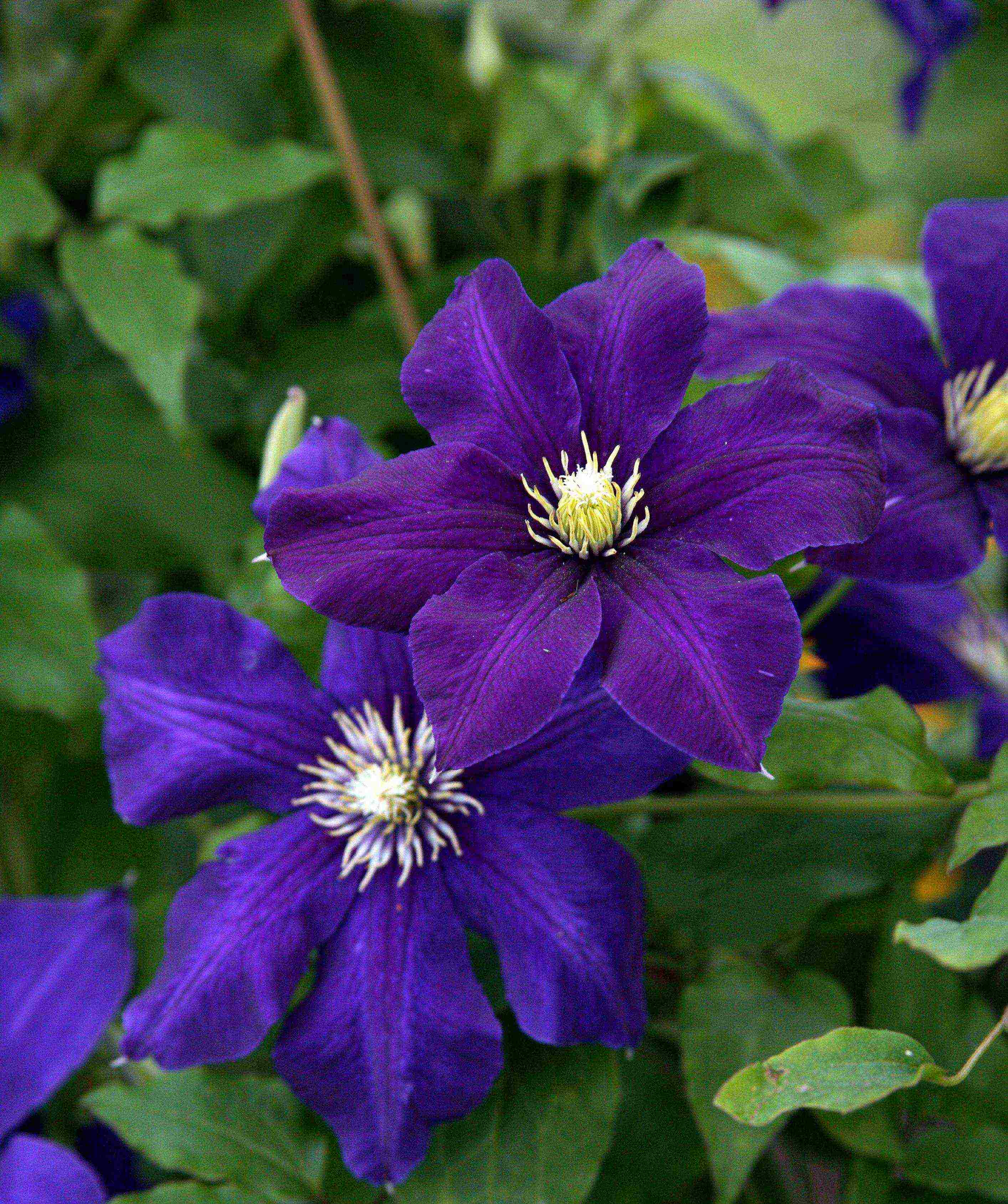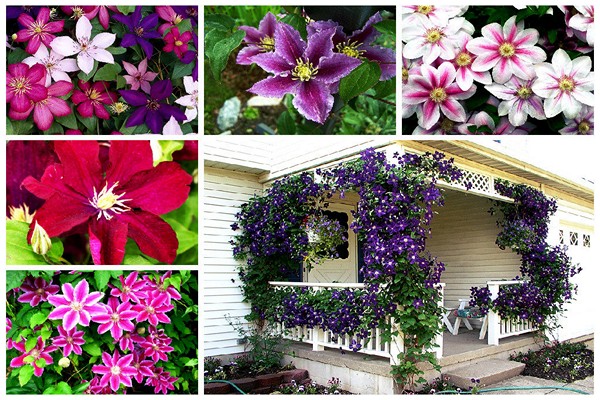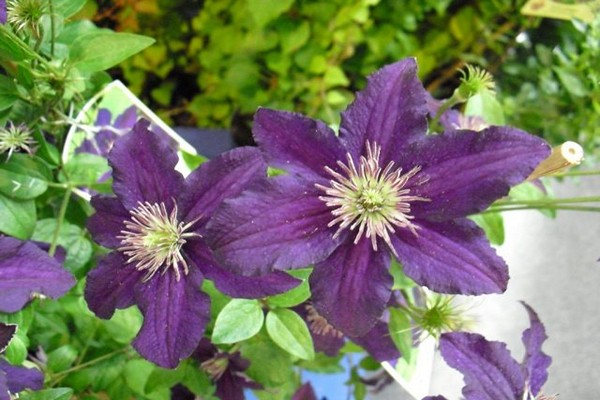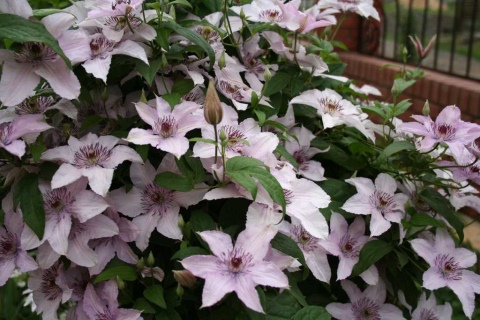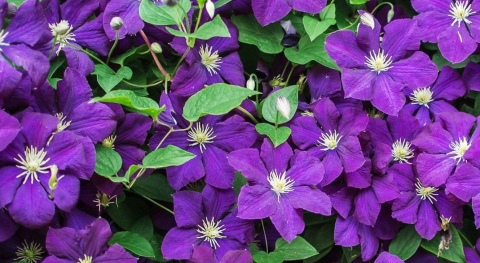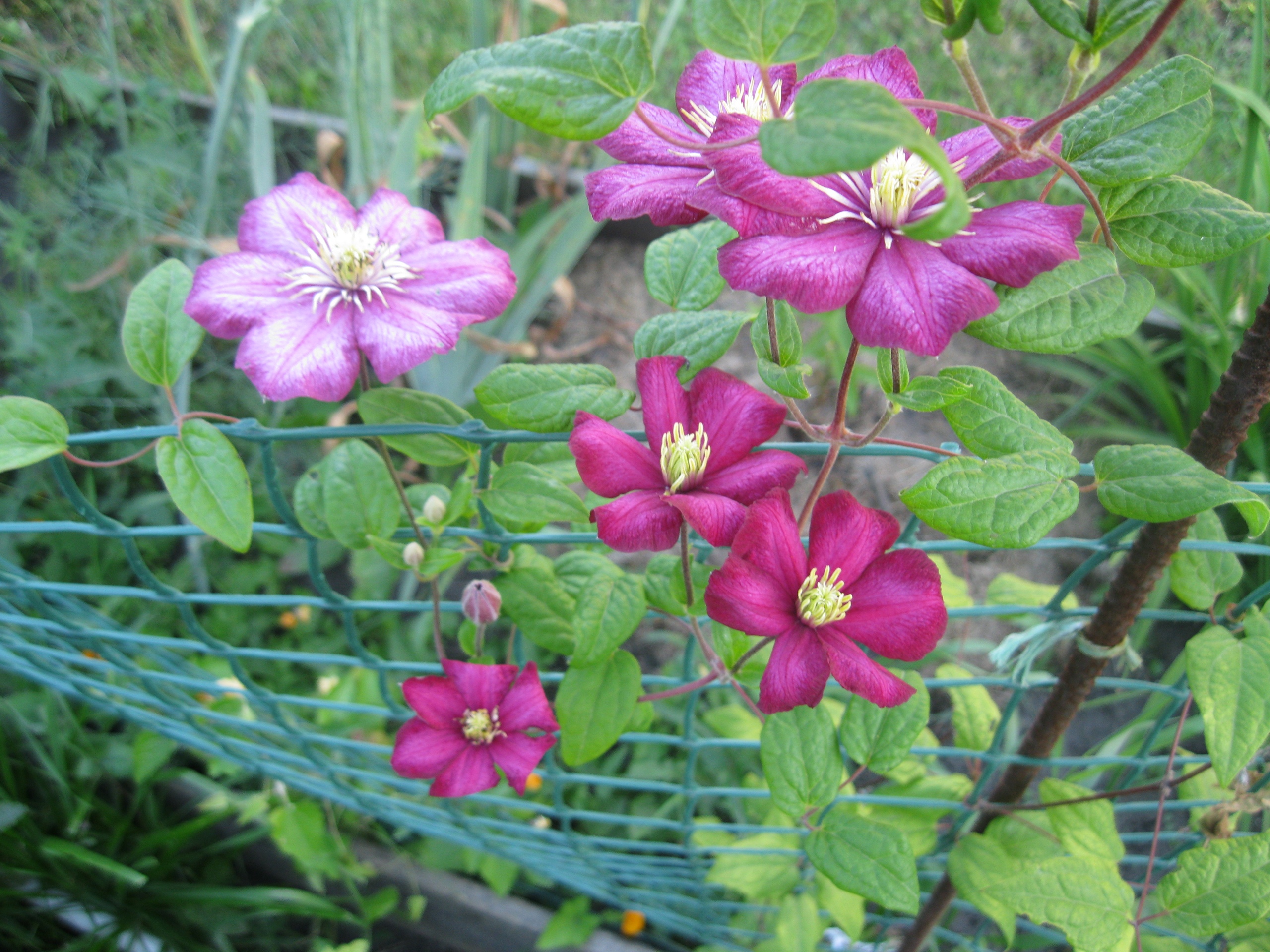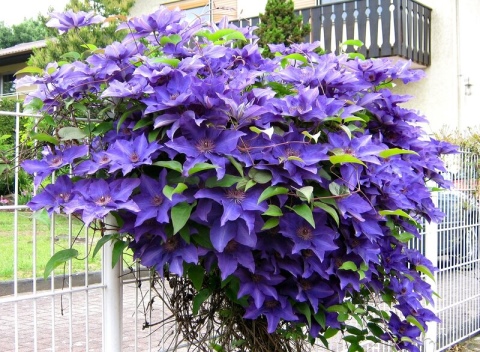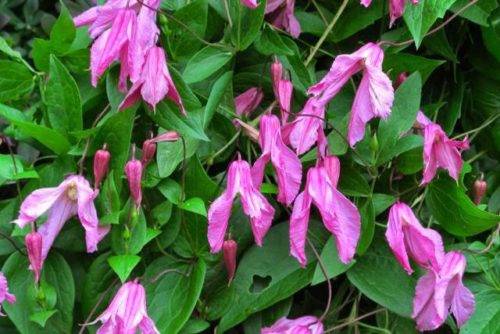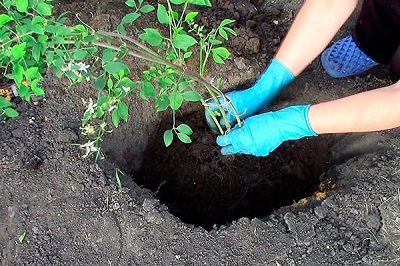Further care
Further, the hybrid is provided with full-fledged care, which includes watering and feeding, loosening and mulching, garter and sanitary pruning, prevention of diseases and pests, preparation for winter.
Watering and fertilizing
Large buds with a rich shade appear on clematis only if there is sufficient moisture. In the event that the shrub vine is planted on the southern side of the site, it will have to be irrigated once a day. One adult hybrid consumes about a bucket of water, but this parameter is adjusted depending on the weather. Make sure that the water does not stagnate, otherwise it will lead to an outbreak of fungal diseases and rotting of the roots of clematis.
During the rooting period, the hybrid does not need additional nutrients. After the plant finally adapts to a new place, feeding is carried out according to the following algorithm:
- Spring - use a fortified complex, which must contain nitrogen.
- The period of bud setting - phosphorus and potassium are introduced, complex mineral fats are used.
Mulching and loosening
After each moistening, loosening of the soil is mandatory. This event will prevent the formation of a dry crust and get rid of weeds that take away food from clematis. With the onset of autumn, the soil around the hybrid is covered with a layer of mulch. For this, any organic material is used, it can be compost or humus. The required layer is about 15 cm.
Sanitary pruning
For the first few years, the hybrid spends all its energy on adapting to a new place and rooting, as well as on building up the root system. Because of this, few colors appear, or they are completely absent. Experienced gardeners recommend immediately removing faded buds, then the plant will not waste energy on them, but will begin to throw out new ones. In the first season, one central shoot is left, its height should not exceed 20 cm.This event will allow the plant to grow side shoots better. All old, diseased and dry branches are cut out.
Tying
Since the vine grows strongly both in width and in length, without tying it up, it will not be possible to maintain its decorative appearance. To do this, use special support lattices or allow the liana to curl up trees or fences.
Diseases and pests
The immunity to diseases in the hybrid is average, most often it is affected by different types of rot. Their occurrence is provoked by improper agrotechnical care - poor shelter for the winter or excessive watering with cold water. In this case, the hybrid is transplanted, all damaged parts are removed and the care of the plant is normalized.
Of the insect pests, the most dangerous are nematodes, for which there is no cure. They damage the root system and the plant dies. Spider mites and thrips are also found on the hybrid. To eliminate pests, any insecticide is used, for example, "Actellik".
Preparing for the winter period
The correct preparation of the hybrid for winter depends on how abundant the flowering and health of the crop will be. In autumn, the soil around the clematis is treated with a fungicidal preparation and covered with a layer of mulch. A little wood ash is poured on top of the mulch. When the soil freezes to -5 degrees, the hybrid is covered using wooden boxes, burlap or roofing felt. If enough snow has fallen, it is scooped up to the roots of the plant to insulate them.
Description of the variety
Clematis "Multi Blue" is a blooming liana that can be used to decorate a garden plot, terrace or balcony in an original way. Basically, gardeners prefer perennial large-flowered varieties of clematis, which include "Multi Blue".Flowers have gained such wide popularity due to their chic decorative appearance, abundant flowering and their unpretentious care.
The “Multi Blue” variety is included in the Patens group and was bred on the basis of the “Raskidisty” variety. It is characterized by the formation of flowers not only on last year's shoots, but also on newly appeared ones. With proper care, hybrid clematis re-blooms, which can occur towards the end of summer. A distinctive feature is strong variability, since flowers of the same variety can be different in shape and have differences in shade.
The main features of the variety.
- "Multi Blue" is a bushy vine. During the year, the branches grow about 2 meters. However, in the case of growing in a flower pot, the height of the plant is 20-40 cm.
- Annual shoots are thin, flexible vines of a dark brown hue. With age, the branches begin to lignify, but do not lose their elasticity and cling well to the support.
- Possesses a powerful branched root system. Unlike other varieties of clematis, the roots of "Multi Blue" are very close under the soil surface. For this reason, experts do not recommend loosening the soil directly under the Multi Blue clematis bushes, as this can lead to the death of the plant. It is better to replace loosening the soil with mulching the soil under the bushes and in the immediate vicinity.
- The leaf plate is oblong, rather large and reaches 10 cm in length. The leaves are dark olive green.
- Flowering is characterized as early and long lasting. It starts from early or mid-May and lasts until the end of August, and in warm weather and the absence of frost, flowering can continue in September.
- Flowers can be of different colors: from blue-violet with a bluish tint to pink with a white border. Flowers appear mainly on last year's shoots, up to 18 cm in diameter. Inflorescences consist of 4-8 oblong double petals arranged in two circles. The upper petals are predominantly rounded-oblong with sharp tips. They are short and vertical. The lower petals are flatter and larger. Petals of different shapes give the flower originality. The short petals, shaped like a lancet or needles, are positioned vertically upward. In the center of the flower there are stamens of yellow, red, light green or white. The color depends on the stage of formation and opening of the bud.
- With proper care, a clematis bush can grow in one place for up to 20 years.
Preparing for winter
"Kaiser" is considered a frost-resistant variety, but in the middle zone of our country it winters well only with shelter. At the same time, the plant can grow out, and the process of winter protection should also be taken with full responsibility. They cover clematis when the air temperature drops to -5 ° C and the soil begins to freeze. The bush is removed from the support and carefully laid on a layer of spruce branches or dry foliage, covered with the same material on top and covered with a layer of peat or sand. The thickness of the entire shelter should be approximately 15 cm.
If the winter turns out to be very frosty, the protection will need to be strengthened. Then the bush is covered with a wooden box on top, and additional small bags of straw or sawdust are placed on it. The box can be replaced with a frame on which additional insulation will be held. When using synthetic materials, leave openings for ventilation of the entire structure.
Planting and caring for clematis Nelly Moser
Clematis varieties Nelly Moser does not require much care - even a beginner in floriculture can handle it. The main thing is to comply with the landing dates and a few simple rules.
The timing of planting clematis varieties Nelly Moser depends on the region where it grows. For the northern regions and the climate of the middle zone, this is the end of April or the first days of May. Autumn planting is also possible. In this case, the procedure is carried out in September.In the southern regions, the flower of this variety is best planted in early October.
Choosing the right place
An ideal place for clematis would be an area where it is sunny in the morning and no heat at noon. For warm areas, the eastern side is chosen for planting. If there are several plants, then a distance of 1 m is maintained between them.
The root system of clematis is almost completely located at the top, so the flower must be hidden from direct sunlight. Otherwise, the plant may overheat. It is also worth making sure that clematis is not exposed to strong winds, which can break fragile shoots. In the lowlands, the liana will begin to rot from an excess of moisture.
Selection and preparation of planting material
Since clematis of the Nelly Moser variety is a perennial, the choice of planting material should be taken seriously. A good seedling has the following characteristics:
- the root is a structure of five processes at least 30 cm in length;
- all roots are of the same thickness, there are no growths and other formations on them;
- the stem has at least 2 well-developed buds.

If for some reason a weak clematis seedling is acquired, then it is better not to plant it immediately in open ground, but place it in a greenhouse. There he will get stronger and next year he will be ready to move to a permanent place.
Landing algorithm
Clematis varieties Nelly Moser, like everyone else, loves soil rich in nutrients and humus. For the successful development of the root system, the soil must be sufficiently loose. Loamy and sandy loam soils are well suited; in other cases, it is necessary to add sand when planting.
A hole is dug 60 cm wide and deep. A drainage must be placed at the bottom, in the form of a small stone with a layer of 15 cm. Then a mixture of humus, ash peat and mineral fertilizers for flowers is placed in the hole. Such preparation must be completed a month before the expected planting of clematis.
Important!
When planting in the center of the pit, it is advisable to place a peg to which the plant will tie. When placing a seedling in a hole, make sure that the root collar is located in the soil at a depth of no more than 12 cm
Thus, the flower is protected from frost and excess moisture.
When placing a seedling in a pit, it is necessary to ensure that the root collar is located in the soil at a depth of no more than 12 cm. Thus, the flower is protected from frost and excess moisture.
Planting algorithm of the variety:
- part of the land must be removed from the pit to accommodate the root system of clematis;
- a small slide is formed in the center;
- if the seedling is with a lump of earth, then it is simply lowered into the hole, and if the roots are bare, then they are spread over the hill;
- water must be poured into the pit;
- the roots are sprinkled with a layer of sand, and then with fertile soil.
After that, the plant must be watered, and the soil next to it must be mulched. It is recommended to use peat for this.
Planting and caring for clematis Mazuri
Large-flowered clematis (marque) Mazury is widely represented on the market. A marque indicates that the root system was in a moist substrate and the plant was kept refrigerated. Here are some helpful tips for choosing clematis varieties.
Before planting the Mazury variety, you need to choose a place where the plant will feel best and will reveal its full potential. The site must meet the following requirements:
- Good light: although Mazury can grow in partial shade, it will thrive best in the sun.
- Windproof. When planting clematis, you must take into account the wind rose on the site.
- Moderate humidity. It is not recommended to plant the Mazury variety near houses along the line of water flow from the roof and next to metal fences from a profile sheet. You can not place the plant in lowlands flooded with water during rains or melting snow.
In central Russia, the Mazuri variety is planted only in the spring, and in the southern regions this can be done in the fall.
Landing should be done as follows:
- Dig a hole 50x50x50 cm in size. The root system of clematis is superficial, so 50 cm depth will be enough for the plant.
- Lay a drainage layer on the bottom to avoid root rot.
- If the soil is clayey, the pit should be filled with humus: best of all with horse or cow (1 part), with the addition of river sand (2 parts).
- The plant must be planted in a cone formed in the center of the hole.
- Spread the roots of the vine.
- If the stalk, prepared for planting, has a lignified trunk, then the neck of the bush, where the buds are located, must be buried 10 cm into the ground.
- If new shoots have already begun to grow, then planting should be carried out in such a way that at the end of summer the whip can be covered with a layer of earth of 10 cm.
- Clematis Mazury is spilled and made sure that the soil does not dry out.
- The ground around the plant is mulched by 15 - 25 cm.
All care in the first year planting for clematis varieties Mazuri will consist in timely watering and monitoring that the stems of the plant stretch along the supports.
Preparing for winter:
- a bucket of humus is poured onto the roots of clematis Mazuri;
- remove the vine from the supports and lay it on the formed hill;
- take measures to prevent the kidneys from gnawing mice: cover with spruce branches, or a rag dipped in vinegar or tar;
- the top is covered with a layer of non-woven material.
Spring activities:
- when the snow melts, the vines are pruned according to the third type;
- level humus poured in autumn;
- Clematis Mazury should be covered with non-woven material from the aggressive spring sun and possible frost;
- during the growing season, when the buds begin to grow, the plant is watered 2 times with nitrogen fertilizer;
- in the future, top dressing of clematis is carried out with an emphasis on phosphorus and potassium.
The size of the vine's root system greatly affects the survival, growth of the bush and the abundance of flowering.
The video will help you learn more about how to get the plant to bloom magnificently:
Care rules
With proper and regular care, the "Hegley Hybrid" variety gives abundant flowering, forms shoots well in the first year of its life. To do this, clematis must be sure to provide regular watering every other day with the introduction of 10 liters of water under the bush. But such abundant irrigation is necessary only during dry periods of the year. If the land is wet, there is no need to create conditions for waterlogging of the soil and the development of fungal diseases.

Plants are also fed according to a certain scheme. Hybrid clematis of this variety require regular feeding.
- The first fertilizers should be applied immediately after the snow melts, in the second year after planting. By the end of April, the bush should receive nitrogen fertilization, which stimulates its growth and development.
- The second fertilization is done in the second half of May. It already requires the use of complex mineral fertilizers. The application is carried out under the root in the form of an aqueous solution.
- In June, before the beginning of flowering, it is necessary to add potassium and phosphorus to the "diet" of plants. They dissolve in water and are applied when watering in the evening.
- In August, wood ash is introduced into the soil under the root. After filling with dry powder, it is necessary to water the soil with warm water.
- The last top dressing in the form of organic fertilizer is applied at the end of the flowering period, after wintering.









